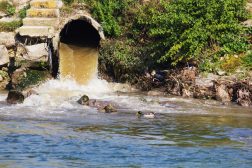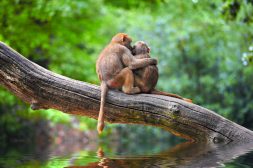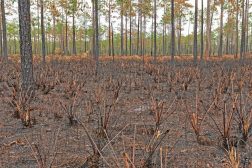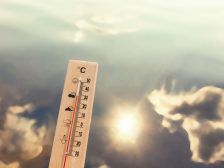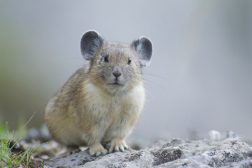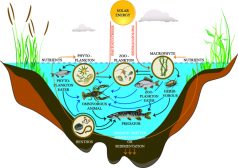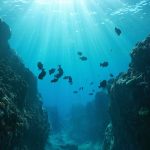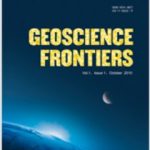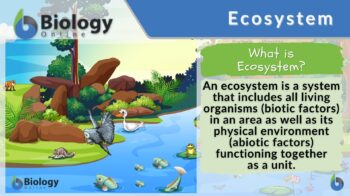
Ecosystem
n., plural: ecosystems
[ˈiːkəʊˌsɪstəm]
Definition: A system that includes all living organisms (biotic factors) in an area as well as its physical environment (abiotic factors) functioning together as a unit.
Table of Contents
Ecosystem Definition
An ecosystem is a system consisting of biotic and abiotic components that function together as a unit. The biotic components include all the living things whereas the abiotic components are the non-living things. Thus, an ecosystem science definition entails an ecological community consisting of different populations of organisms that live together in a particular habitat. Natural sciences like ecology and geography define an ecosystem as a geographic area where organisms, weather, and landscape, work together to form a “bubble of life”. (Ref. 1)
How about in biology, what is an ecosystem? In essence, the ecosystem definition in biology is that it acts as the fundamental unit of nature. (Ref. 2) Just as a living organism is made up of cells that act as the structural and functional units of life, nature also consists of fundamental units called ecosystems.
What is a simple definition of an ecosystem? An ecosystem is a community plus the environment. Ecology, which is the scientific study of the interactions between populations or between organisms and the environment, can be viewed at the level of an individual, a population, a community, or an ecosystem.
Ecology at the level of individuals is concerned chiefly with the individual organism’s physiology, reproduction, and development. At the level of population, ecology deals primarily with the attributes and the various factors affecting the population. At the level of community, ecology studies the interactions between populations and community patterns. At the level of an ecosystem, ecology puts all of them together to understand how the system operates as a unit. Thus, an ecosystem ecology would be more concerned about energy flow and nutrient cycles than about individual species. (Ref. 3)
Etymologically, the ecosystem meaning and origin can be traced back to the Ancient Greek “οἶκος” (“oîkos”) for “house” and “σύστημα” (“sústēma”) for “organized body”. The term was coined in the early 1930s by the botanist, Roy Clapham, to denote the physical and biological components of an environment. However, it was the British Ecologist, Arthur Tansley, who first introduced the concept in his paper entitled “The Use and Abuse of Vegetational Concepts”. (Ref. 4, 5)
Synonyms: environs; ecological community.
Ecosystem Structure
The structure of an ecosystem consists of two major components:
(1) biotic components
(2) abiotic components
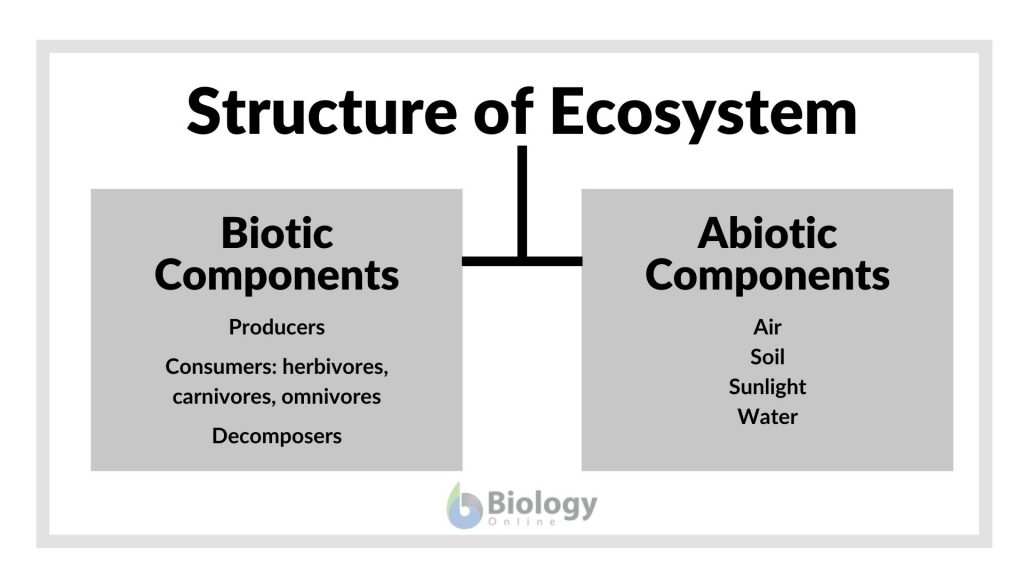
(1) Biotic components
The biotic components include all living things. There are two major types of living things. They are the eukaryotes and the prokaryotes. Eukaryotes are characterized by having membrane-bound organelles (such as a nucleus) inside their cells. The prokaryotes, in turn, are those lacking membrane-bound organelles. For further differences between these two groups, read this). Examples of eukaryotes are plants, animals, fungi, and protists. Bacteria and archaea represent the prokaryotes. Now, each of them has a “job” to do in the ecosystem.
Plants, for instance, have chloroplasts that enable them to harvest light energy. Then, they take carbon dioxide and water from their environment to convert them into sugar, a biomolecule that can be used to synthesize chemical energy (such as ATP). Because they are capable of producing their own food through photosynthesis, they are referred to as the producers. Next to the producers are the primary consumers. They feed on the producers while they serve as a food source to the higher levels of consumers (e.g. secondary and tertiary).
The animals are examples of consumers. The animals that feed on plants are called herbivores whereas those that feed on other animals are carnivores. Then, there are those that feed on both plants and animals. They are called omnivores.
(2) Abiotic components
The abiotic components include all the non-living things, such as rocks, soil, minerals, water sources, and the local atmosphere. Similar to biotic components, the abiotic components also have their ecological role. For example, elements and compounds serve as sources of nutrients. They are essential to the growth and metabolism of an organism. Apart from providing nutrients, they also provide organisms a place to live and thrive — a habitat.
Interactions
The biotic and the abiotic components interact with one another as a system and are linked to one another via nutrient cycles and energy flows. For instance, energy and nutrients enter the system via the photoautotrophs. They are organisms that carry out photosynthesis, such as plants and green algae. Then, the heterotrophs, for example, animals, feed on the photoautotrophs. This makes the energy and the nutrients move through the system. The death of these organisms incites decomposition by the decomposers. This process releases the nutrients back to the environment to be re-used by the organisms.
To learn more about this, proceed to: Processes of the Ecosystem.
The biotic and abiotic components can also serve as environmental (ecological) factors that affect the ecosystem. The biotic components whose biological activity creates an impact on the ecosystem are referred to as the biotic factors. The abiotic factors, in turn, include the non-living things and the physical aspects of an ecosystem, such as climate, temperature, and pH.
An example of a biotic factor is the extent of predation in an ecosystem. If there is an increase in the number of predators, predation activity would likely increase. This, in turn, could significantly lessen the population density of their prey. If their prey is a key species, meaning another group of organisms depends on them for survival, then the decline (or worse, the extinction) of these key species could also lead to the decline (or worse, the extinction) of the organisms relying upon them.
As for the abiotic factor, they can regulate the size or the density of a species population. For instance, acid rain, which is unusually acidic precipitation and has high levels of hydrogen ions, can produce detrimental effects on the soil (e.g. leaching) as well as on the plants and aquatic animals that are sensitive to low pH. Apart from pH, other abiotic factors are light, salinity, air, soil or substrate, and temperature.
Types of Ecosystems
What are the 4 types of ecosystems? The four types of ecosystems are terrestrial, freshwater, marine, and artificial. The first three occur naturally in various biomes. The last one is man-made. Ecosystems vary in size — from the micro-ecosystems (e.g. tree ecosystems) to the largest ecosystems such as ocean ecosystems.
(1) Terrestrial ecosystem
The terrestrial ecosystem occurs on land. Examples of land-based ecosystems are forest ecosystems, grassland ecosystems, tundra ecosystems, and desert ecosystems.
A forest ecosystem consists of various plants, particularly trees. Because of the abundance of plants that serve as producers, this ecosystem abounds in life. Not only plants but also animals are teeming in a forest. They are also a great source of fruits and wood, They also help maintain the earth’s temperature. They are also a major carbon sink. (Ref.6)
Grassland ecosystems are typically found in tropical or temperate regions. They are dominated by grasses. As such, the animals commonly found in this type of ecosystem are grazing animals, such as cattle, goats, and deer.
Tundra ecosystems are characterized as being treeless and snow-covered. The snow melts briefly in spring and summer, producing shallow ponds. During this time, lichens and flowering plants typically grow. Because of the ice that covers the land in the tundra, this type of ecosystem is important in regulating the earth’s temperature. It also serves as a water reservoir (in the form of ice or frost).
Desert ecosystems are the ones occurring in desert habitats. Deserts are typically arid and windy. Some of them contain dunes, others, mostly rock. Organisms in the desert are not as diverse as those in forests but they possess adaptations that make them suited to their environment. Plants that are commonly found in the desert are CAM plants, such as cacti. Desert animals include insects, reptiles, and birds. (Ref.7)
(2) Freshwater ecosystems
Freshwater ecosystems are aquatic ecosystems that do not contain saltwater. They are home to algae, plankton, insects, amphibians, and fish. There are two major types: lentic and lotic ecosystems.
A lentic ecosystem refers to ecosystems in still waters. Examples include the following: ponds, puddles, and lakes. Lakes, in particular, may form zonation. That is when it becomes very well established that different zones are formed. These zones are as follows: littoral, limnetic, and profundal. The littoral zone is the part that is near the shore. Here, light can penetrate up to the bottom. The limnetic zone is the zone in which light does not completely penetrate through. The part of the limnetic zone that is penetrated by light is the photic zone whereas the zone in which light cannot penetrate through, and therefore is dark, is the benthic zone. The plants and animals vary in these zones. For instance, rooted plants are found in the littoral zone but not in the limnetic zone. Rather, freely-floating plants are the ones commonly seen on the surface of the limnetic zone.
A lotic ecosystem is an aquatic ecosystem characterized by a freshwater habitat that is freely flowing. That is as opposed to the lentic, which is nearly stationary. Examples include rivers and streams. Many plants and animals in these ecosystems have adaptations to help them cope with the force and the different conditions that running water brings.
(3) Marine ecosystem
A marine ecosystem is an aquatic ecosystem that contains saltwater. Examples are the ecosystems in the seas and oceans. The ocean ecosystems, in particular, are an important source of atmospheric oxygen due to the vast population of autotrophic algae that release oxygen through photosynthesis. Marine ecosystems are regarded as the most abundant type of ecosystem in the world. ( Ref.7 )
(4) Artificial ecosystem
An artificial ecosystem is a man-made system, which can be further classified as terrestrial, freshwater, or marine. An example of an artificial ecosystem is a terrarium. Many man-made ecosystems are built for conservation purposes, aesthetics, and studying biology and ecology.
Processes of the Ecosystem
In an ecosystem, energy flows while materials are cycled. These two processes are linked and essential to the structure, function, and biodiversity of an ecosystem. Let’s take a look at the figure below to understand them further.
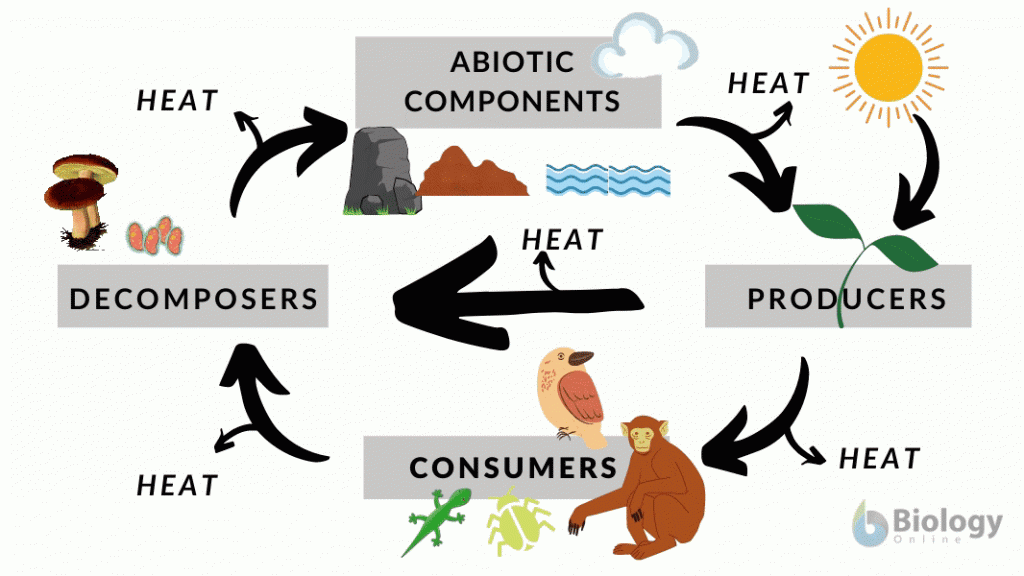
Energy flow
In ecology, the term productivity refers to the rate of generation of biomass in an ecosystem. It is often expressed in units of mass per volume per unit of time, e.g. grams per square meter per day (g m−2 d−1). Productivity may be primary or secondary. Primary productivity refers to the productivity of the autotrophs, such as plants, whereas secondary productivity refers to that of the heterotrophs, such as animals. (Ref. 8)
The primary production of biomass is often attributed to plants and algae performing photosynthesis. That is because virtually all energy available to organisms starts with them. (Ref. 3) Energy from the sun is captured by the chloroplasts (organelles containing chlorophyll, the green pigment) inside the cells of photoautotrophs. Inside the chloroplast, the light energy (in the form of photons) drives the conversion of inorganic substrates into energy reserves, like sugar molecules. In general, animals have no such pigments to capture light energy that will enable photosynthesis. Therefore, they have to rely on autotrophs and/or other heterotrophs for food.
Photosynthesis is a biological process through which plants manufacture their own food with the aid of light from the sun and inorganic sources (e.g. carbon dioxide and water). They produce glucose molecules, for instance, that can be stored later as starch. The plants, in turn, serve as a food source for organisms that are incapable of producing their food.
By feeding on these plants, the energy (as well as the nutrients) flows from the producer to the consumer. Then, it flows from one consumer to the next. Complex organic molecules in food, such as carbohydrates, fats, and proteins are rich sources of energy stored in their chemical bonds. In the presence of oxygen, glucose (a sugar molecule), for instance, is processed to synthesize chemical energy (ATP) via cellular respiration. Energy stored in food molecules is released through a series of oxidation reactions. Electrons are passed on from one molecule to another until they reach the final electron acceptor, which is oxygen. As the food molecule is fully oxidized, the final byproduct is carbon dioxide, which is released, for example through transpiration in plant stomata and exhalation in breathing animals. In the absence of oxygen, cells carry out fermentation wherein glucose is broken down to generate ATP and produce lactic acid. In animals, the excess energy from dietary sources is stored in energy-rich molecules, such as glycogen and lipids.
Decomposers are the last group of organisms through which energy flows through. They consume the droppings and carcasses of all living things.
Look at the figure below. It shows a simple diagram of a food chain and the flow of energy and nutrients. It starts with the producers, such as plants, that manufacture food by capturing light energy from the sun. Energy flows next to the consumers, particularly the primary consumer (insects), the secondary consumer (frog), the tertiary consumer (snake), and lastly, to the quaternary consumer (eagle). Then, the droppings or the carcass of the eagle will be broken down by the decomposers.
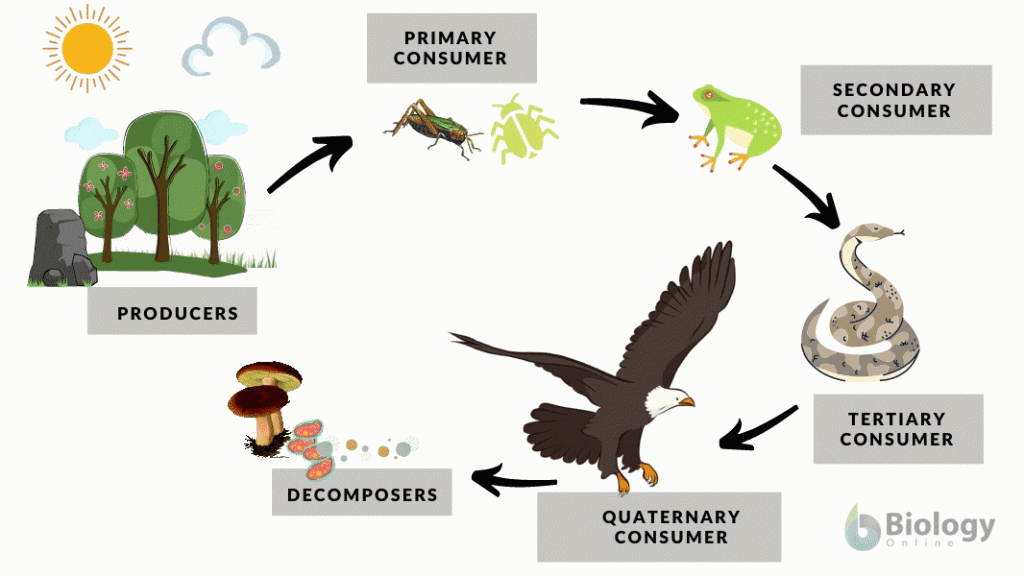
Biogeochemical or nutrient cycling
Elements, such as carbon, nitrogen, or phosphorus, enter a living organism in different ways. One example is by plants directly taking them up from their physical environment, for example via roots absorbing elements available in the soil and gases entering through stomata. In animals, these elements enter via food consumption. Droppings and decaying organic matter are broken down by decomposers, ultimately releasing these elements for nutrient cycling, or for use by other living organisms. This ecological process in which decomposers break down organic matter by decomposers is called decomposition. In decomposition, these materials are neither lost nor destroyed, and therefore the planet, in this regard, is a closed system. The elements will be cycled between biotic and abiotic states within the ecosystem. (Ref. 3)
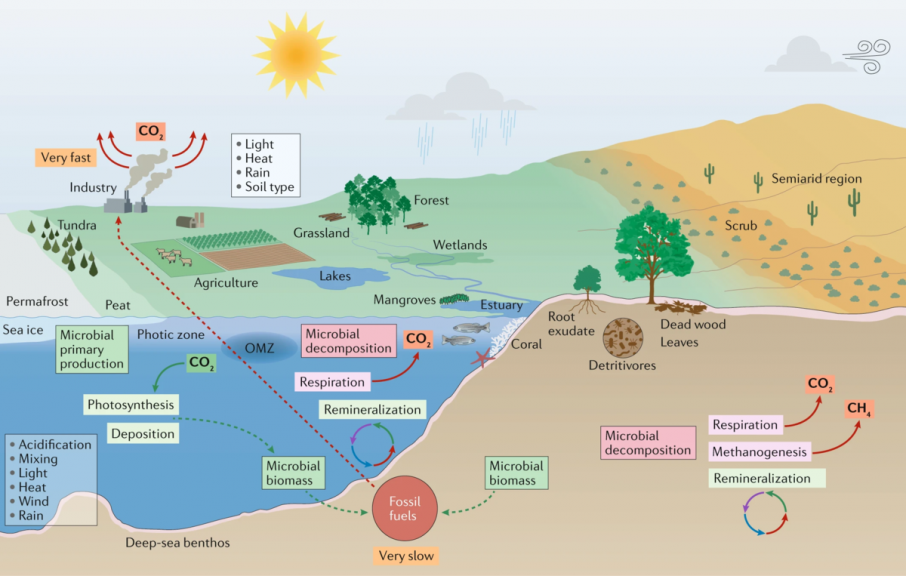
Community dynamics
Ecosystems are dynamic. Their composition and structure may change over time especially when a disturbance occurs. For example, a volcanic eruption is a natural disturbance that can create a new land that is open for colonization. Oftentimes, the first species to colonize a barren land are lichens. Eventually, their biological activities will alter the condition of the environment. This will make it less harsh and more habitable for new species. The progressive replacement of one dominant type of species or community by another is called succession. This succession will go on until a climax state is established, meaning the ecosystem has achieved stability and no further successions will occur unless another disturbance disrupts the ecological balance. For example, a massive flood wiped out a previously stable community. The land will be open again for colonization. A succession in which the new land is colonized for the first time is referred to as primary succession whereas a succession in an area that was previously occupied by a community but was disturbed and replaced by recolonization is called secondary succession.
Take a look at the schematic diagram of succession below. You will notice that the process started as a barren land with bare rocks. The pioneer species, like lichens and moss, will grow on the rocks and will become the pioneer species. Then, the site is next colonized by grasses and herbaceous plants. Soon, trees will grow on this site when their seeds reach the site, for example by wind currents or by bird droppings containing undigested seeds.
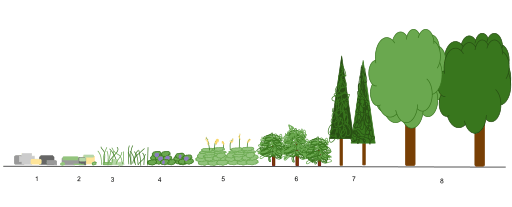
Function and biodiversity
Ecosystems are responsible for the cycling of nutrients and for allowing the flow of energy, such as from the sun to the biotic components. The various biological, physical, and chemical systems work together in maintaining the stability of these systems on earth. Biodiversity is essential for an ecosystem to function. Biodiversity refers to the biotic components. The more diverse the biotic components are, the “healthier” the ecosystem will be. That is because each species has an important role to play. The more diverse the species are, the greater is the chance that the ecosystem will persist and continue to function. High diversity in an ecosystem can help improve productivity and thereby stabilize the functioning of an ecosystem.
Examples of Ecosystem
Examples of ecosystems described here are the following:
- Deciduous forest ecosystem
- Savannah ecosystem
- Coral reef ecosystem
- Hot spring ecosystem
- Micro-ecosystems
Deciduous forest ecosystem
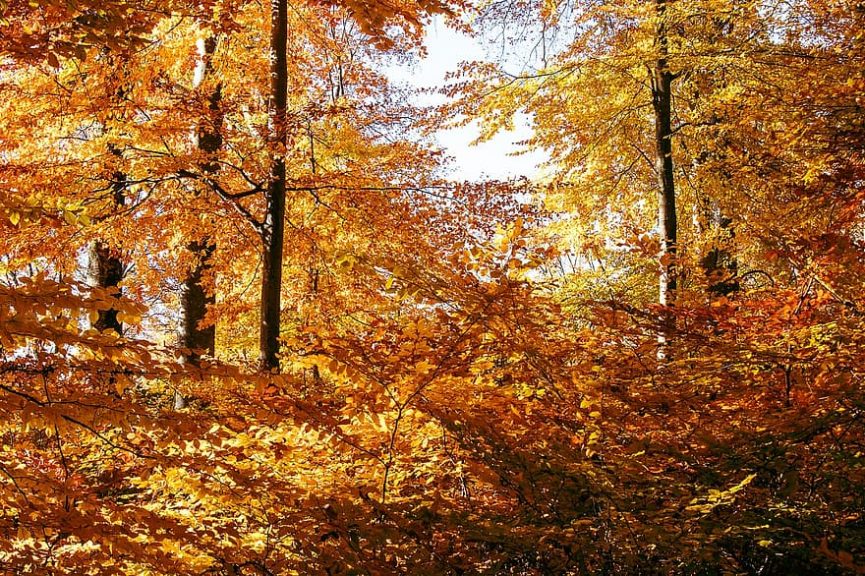
A deciduous forest is dominated by trees that shed leaves seasonally and then regrow their leaves at the start of the new growing season. They shed leaves as an adaptive mechanism against the cold season in temperate regions or the dry seasons of the subtropical and tropical regions. The dominant trees in mid-latitude are oaks, beeches, birches, chestnuts, aspens, elms, maples, and basswoods. (Ref. 9) In the Southern Hemisphere, the dominant tree is the genus Nothofagus (southern beeches). The animals commonly found are snakes, frogs, salamanders, turtles, snails, slugs, insects, spiders, birds (such as warblers, owls, woodpeckers, hawks, etc.), and mammals (such as mice, moles, chipmunks, rabbits, weasels, foxes, and deer). (Ref. 9)
Savannah ecosystem
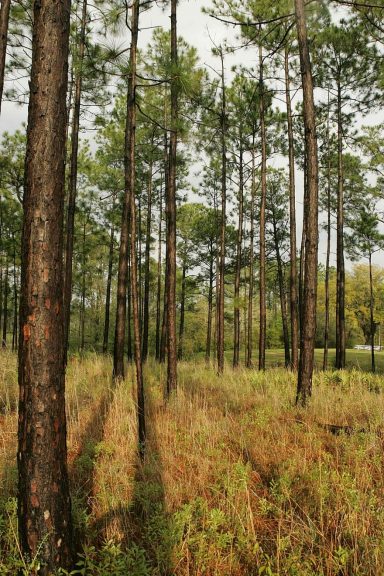
Savannahs are a mix of woodland and grassland ecosystems. The widely spaced, scattered canopy trees allow light to penetrate and reach the ground. Because of that, shrub and herbaceous layers dominated by grasses can grow abundantly as well. Thus, the animals commonly found here are the grazers, such as sheep, cattle, and goats. This type of ecosystem often serves as a transition zone between forest and desert or grassland.
Coral reef ecosystem
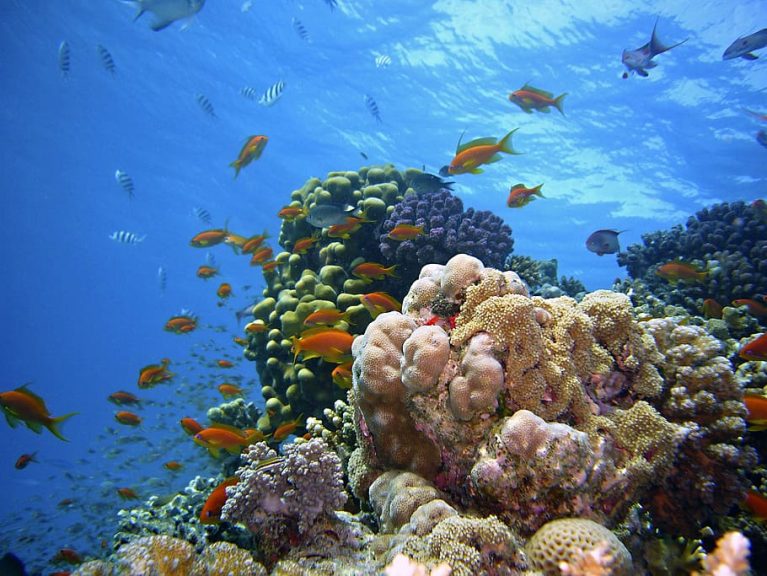
The coral reef is an ecosystem created by reef-building corals. The reefs are colonies of coral polyps, such as stony corals that live together in clusters. They are one of the most diverse ecosystems on earth. As such, they are referred to as the rainforests of the sea. Most of them are found at shallow depths in tropical waters. Some of the species that inhabit the reefs are mollusks, worms, crustaceans, echinoderms, sponges, tunicates, and fish.
Hot spring ecosystem
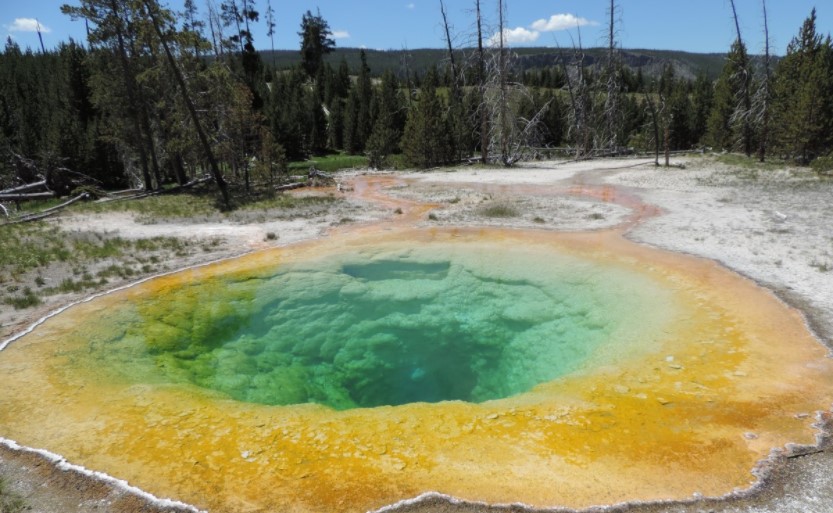
A hot spring is a spring with water temperatures that are higher relative to its surroundings. The water that is coming out of the spring is heated geothermally, i.e. via the heat from the earth’s mantle. Because of the high temperature, it is one of the ecosystems that contain very few types of organisms. Thermophiles are organisms that can thrive at temperatures ranging from 45 to 80°C (113 and 176 °F). Some of these organisms are thermophilic amoeba (such as Naegleria fowleri and Acanthamoeba), thermophilic bacteria (e.g. Legionella), and various archaea.
Micro-ecosystems
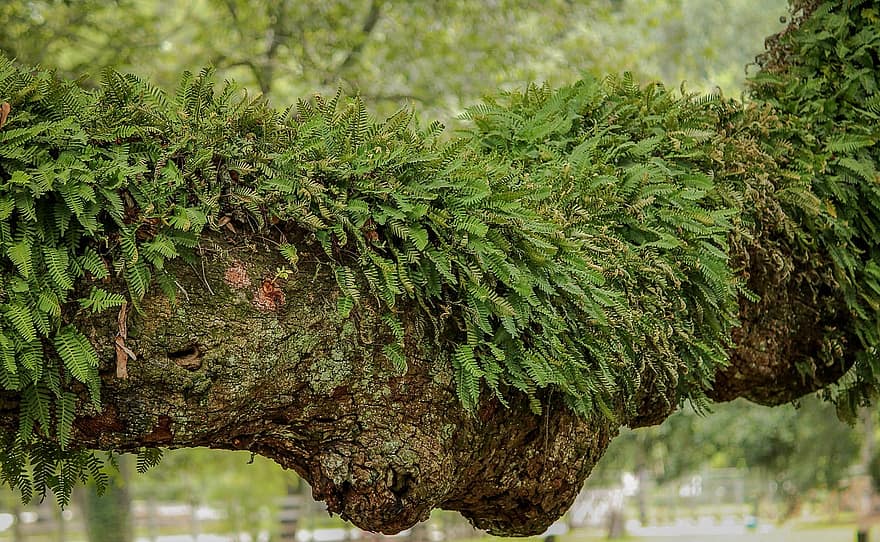
Ecosystems confined to tiny spaces and yet defined by specific environmental factors are called micro-ecosystems. Let’s take a look at a tree ecosystem. A tree creates a small ecosystem where various kinds of organisms live. For example, a tree may harbor lichens and other epiphytes (arboreal plants), invertebrates (such as insects), amphibians, and other animals. The epiphytes, themselves, provide a habitat for other organisms, such as fungi, bacteria, and myxomycetes. (Ref. 10)
NOTE IT!
Beavers — The Awesome Engineers of the Ecosystem
Have you heard of an “ecosystem engineer”? While we are familiar with the engineers and architects of our society, there are other living beings worthy of such an esteemed title with their awesome infrastructures in nature. Among these awesome master builders on Earth are the beavers! Beavers construct beaver dams across a stream or river using tools that nature endowed them with! With the gnaw of their teeth and the slap of their tails, they build an astounding framework of tree branches, twigs, logs, sticks, grasses, rocks, and mud, which subsequently form a beaver pond upstream. As the water starts to gather, they then build within the beaver pond a dome-shaped lodge with multiple chambers — one for nesting, another for food, an air chamber for breathing, and a chamber for entry or escape. Within the beaver lodge, a family of beavers can stay to nurse and raise their young and hide from large predators like coyotes or wolves. And similar to affixing signatures to be identified as the “architect and engineers” of an impressive feat, beavers scent mark their monumental work and their territory with their exudate (called castoreum) from their castor sacs near the base of the tail.
While beaver dams give them a secure space to live, these structures also play a role in orchestrating the flow of streams or rivers and in generating a new kind of habitat for other species. Master builder beavers are, thus, regarded as “keystone species” for their crucial role in the ecosystem. While they alter their environment and shape landscapes, their architectural feat leads to the creation of wetlands and meadows where diverse plants and animals can benefit and thrive.
Source: Build a Beaver Dam (U.S. National Park Service). (2022). Nps.gov. LINK
Answer the quiz below to check what you have learned so far about ecosystems.
References
- National Geographic Society. (2011, August 15). Ecosystem. National Geographic Society. https://www.nationalgeographic.org/encyclopedia/ecosystem/
- Mathematics and 21st Century Biology. (2005). National Academies Press. https://doi.org/10.17226/11315
- The Concept of the Ecosystem. (2017). Umich.Edu. https://globalchange.umich.edu/globalchange1/current/lectures/kling/ecosystem/ecosystem.html
- Willis, A. J. (1997). “The ecosystem: an evolving concept viewed historically”, Functional Ecology 11:2, page 268-271.
- Möller, D. (2020). Chemistry of the Climate System. Berlin Boston: De Gruyter.
- Admin. (2018, March 13). Ecosystem. BYJUS; BYJU’S. https://byjus.com/biology/ecosystem/
- 10 Examples of a Natural Ecosystem. (2017). Sciencing. https://sciencing.com/10-examples-natural-ecosystem-7836.html
- Wikipedia Contributors. (2020, July 31). Productivity (ecology). Wikipedia; Wikimedia Foundation. https://en.wikipedia.org/wiki/Productivity_(ecology)
- deciduous forest | Definition, Climate, & Characteristics | Britannica. (2020). In Encyclopædia Britannica.
- Sydney E. Everhart; Joseph S. Ely; Harold W. Keller (2009). “Evaluation of tree canopy epiphytes and bark characteristics associated with the presence of corticolous myxomycetes” (PDF). Botany. 87 (5): 509–517.
©BiologyOnline. Content provided and moderated by BiologyOnline Editors.

